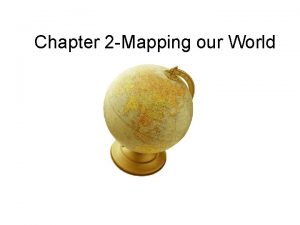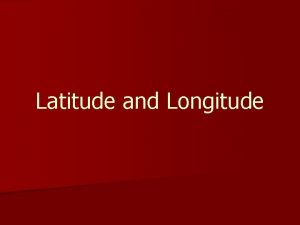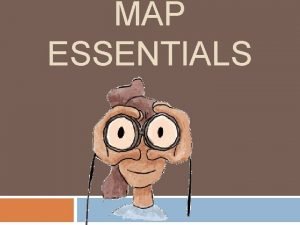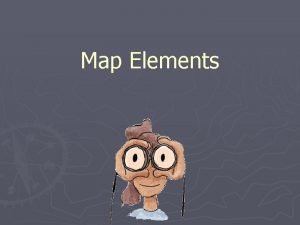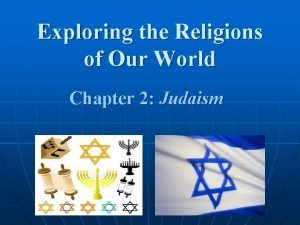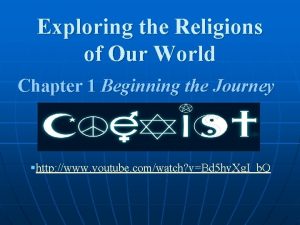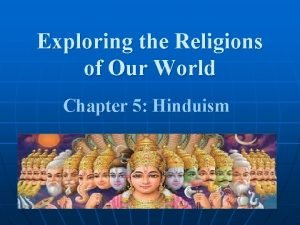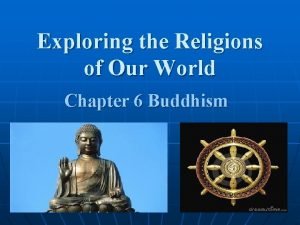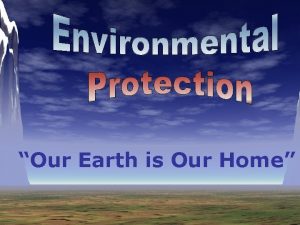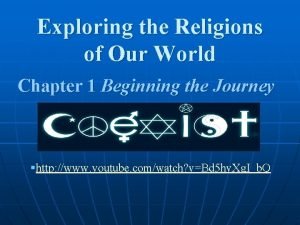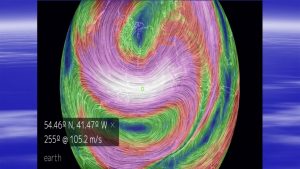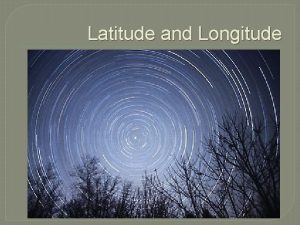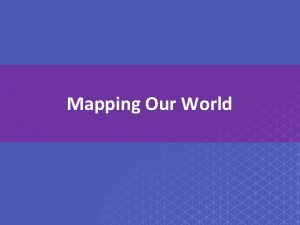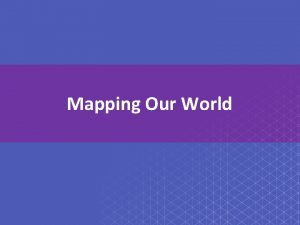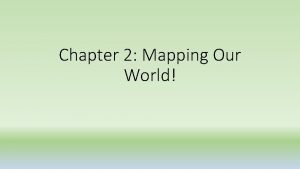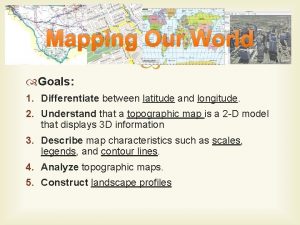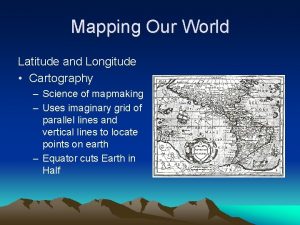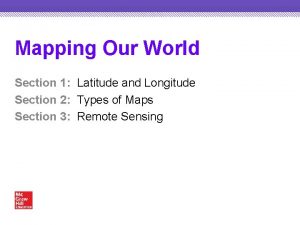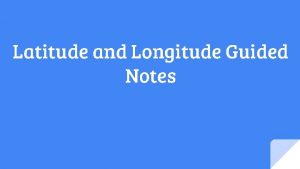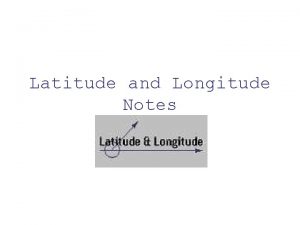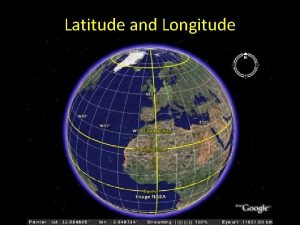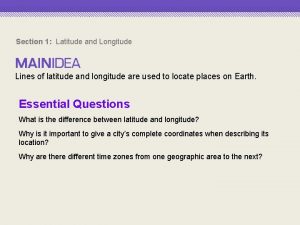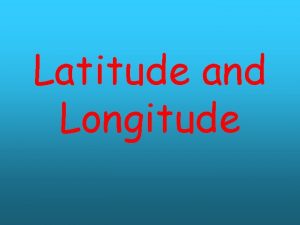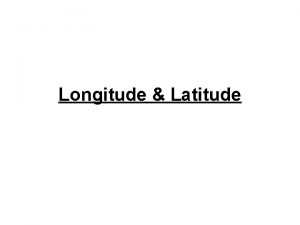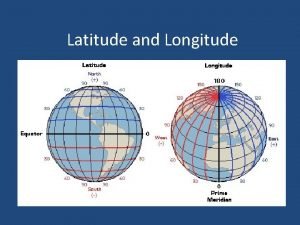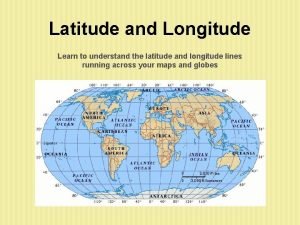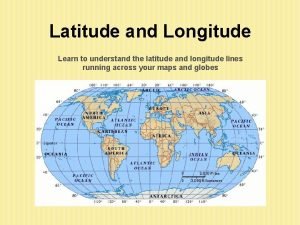Mapping our World Chapter two 1 I Latitude



































- Slides: 35

Mapping our World- Chapter two 1

I. Latitude and Longitude A. The science of mapmaking is called cartography. 1. Cartographers use an imaginary grid of parallel lines and vertical lines to locate points on Earth exactly. 2

2. The equator circles Earth halfway between the north and south poles. 3. The equator separates Earth into two equal halves called north and south hemispheres. 3

B. Latitude 1. Lines running parallel to the equator are called latitude. 2. Latitude is the distance in degrees north or south of the equator. 3. The equator is a reference point numbered at 0 degrees latitude. 4

5

C. Degrees of Latitude 1. Each degree of latitude is equivalent to about 111 km on Earth’s surface. 6

D. Longitude- east and west 1. Longitude is the distance in degrees east or west of the prime meridian, which is the reference point for longitude. 7

8

2. The prime meridian represents 0 degrees longitude. 9

3. Unlike lines of latitude, lines of longitude are not parallel. They are large semicircles that extend vertically from pole to pole 4. Both latitude and longitude are needed to precisely locate positions on earth. 10

E. Time Zones 1. Earth is divided into 24 time zones. Why? Earth takes 24 hours to rotate on its axis. That is why there are 24 time zones. 11

12

F. Calendar dates 1. Each day ends and the next day begin at the stroke of mid night. 2. The International Date Line, or 180 degrees meridian, serves as the transition line for calendar days. 13

3. If you were traveling west across the International Date Line, you would advance your calendar one-day. 4. If you were traveling east, you would move your calendar back oneday. 14

II. Types of Maps A. Maps are flat of three-dimensional object, Earth. 1. A Mercator projection is a map that has parallel lines of latitude and longitude. 2. Projecting points and lines from globe onto a cone makes a conic projection 15

16

3. A gnomic projection is made by projection points and lines from a globe onto a piece of paper that touches the globe at a single point. 17

18

4. Detailed maps showing the hills and valleys of an area are called topographic maps. 5. Elevation on a topographic map is represented by a contour line. 19

20

6. Contour line connects points of equal elevations. 7. The difference in elevation between two side-by-side contour lines is called the contour interval. 21

8. Numbers representing their elevations marks some contour lines. 9. Depression contour lines are used to represent such features as volcanic craters and mines. 22

A. Map legends 1. A map legend explains what symbols represent. 23

2. A map scale is the ratio between distances on a map and actual distances on the surface of Earth. 24

III. Remote sensing A. Electromagnetic spectrum 1. Process of collecting data about earth from far above the earth surface is called remote sensing. 2. Satellites detect different wavelengths of energy reflected or emitted from earth’s surface. 25

3. All electromagnetic waves travel at the speed of 300 00 km/s – speed of light. 4. The arrangement of electromagnetic radiation according to wavelengths is called electromagnetic spectrum. 26

5. An electromagnetic wave also can be described according to its frequency, which refers to then umber of waves that pass a particular point each second 27

28

B. Landsat satellites 1. A landsat satellite receives refelcted wavelengths of energy emitted by earth’s surface, including some wavelengths of visible light and infrared radiation. 29

30

2. Other satellites, such as the Topex/Posedon satellite, use radar to map features on the ocean floor 31

32

3. The global positioning system (GPS) is a radio-navigation system of at least 24 satellites that allows its users to determine their exact position on earth. 33

34

1. 4. Sea beam technology is located on a ship rather than a satellite. 5. Sea beam relies on sonar-sound waves 35
 Chapter 2 mapping our world
Chapter 2 mapping our world Chapter 2 study guide mapping our world
Chapter 2 study guide mapping our world Label the lines of latitude and longitude
Label the lines of latitude and longitude The associative mapping is costlier than direct mapping.
The associative mapping is costlier than direct mapping. Forward mapping vs backward mapping
Forward mapping vs backward mapping Prinsip analisis dan desain
Prinsip analisis dan desain World map with latitude and longitude lines printable
World map with latitude and longitude lines printable North south east west globe
North south east west globe Judaismn
Judaismn Exploring the religions of our world chapter 1 pdf
Exploring the religions of our world chapter 1 pdf Thinking affects our language, which then affects our:
Thinking affects our language, which then affects our: Our census our future
Our census our future Christ, be our light
Christ, be our light Our life is what our thoughts make it
Our life is what our thoughts make it We bow our hearts
We bow our hearts Our census our future
Our census our future Our life is what our thoughts make it
Our life is what our thoughts make it Who wrote the poem money madness
Who wrote the poem money madness Our awareness of ourselves and our environment
Our awareness of ourselves and our environment Our awareness of ourselves and our environment is called
Our awareness of ourselves and our environment is called God our father christ our brother
God our father christ our brother Our future is in our hands quotes
Our future is in our hands quotes Awareness of ourselves and our environment is
Awareness of ourselves and our environment is Our awareness of ourselves and our environment.
Our awareness of ourselves and our environment. Ap world history chapter 25 africa and the atlantic world
Ap world history chapter 25 africa and the atlantic world Exploring religions chapter 5 large
Exploring religions chapter 5 large World heritage is our heritage slogan
World heritage is our heritage slogan Exploring religions chapter 6 large
Exploring religions chapter 6 large “the world is our home” is an example of
“the world is our home” is an example of Exploring the religions of our world
Exploring the religions of our world Romeo and juliet prologue sonnet
Romeo and juliet prologue sonnet Concept mapping chapter 11 genetic disorders
Concept mapping chapter 11 genetic disorders Chapter 34 circulation in humans concept mapping answer key
Chapter 34 circulation in humans concept mapping answer key Concept mapping chapter 28 fishes and amphibians
Concept mapping chapter 28 fishes and amphibians Chapter 28 section 1 fishes
Chapter 28 section 1 fishes Concept mapping chapter 28 fishes and amphibians
Concept mapping chapter 28 fishes and amphibians

